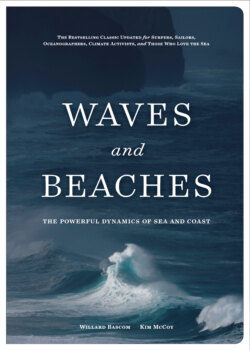Читать книгу Waves and Beaches - Kim McCoy - Страница 32
На сайте Литреса книга снята с продажи.
GREAT STORM WAVES
ОглавлениеWhen sailors talk about the sea it is not long before they are on the subject of storms, great waves, and ship disasters. They speak of wave crests that are “mountainous” and troughs “like the Grand Canyon.” However, when asked to assign dimensions to these features that can be used to test wave theory, their numbers are mostly guesswork—and likely to be on the high side to make their original story sound plausible. Because the heights assigned often do not seem to agree with theory, the question arises whether the eye has been deceived or the theory is inadequate. Moreover, the statistical explanation of wave variability makes it hard to say that any observation is wrong.
Newspaper accounts of exceptionally large waves encountered by ships on stormy passages are likely to relate to the deluge that occurs when the vessel drives her bow head-on into a wave. For example, if the water goes over the navigating bridge and the bridge is 100 feet above the waterline, a 100-foot (30-m) wave is reported. The unexpected impact of even a few tons of broken or “white” water at that level is no doubt a fearsome occurrence worthy of mention, but it is not evidence of wave height. Even if the water were part of a wave, the bridge is well forward of the ship’s center, so that when the bow is down it is well below its proper level. The true wave height would be much less than 100 feet (30 m).
When visibility is good and a large ship is on a reasonably even keel, accurate estimates of wave height, even in a violent storm, are possible. The observer simply watches the distant horizon; when the crest of a wave obscures the horizon, that wave must be higher than the vertical distance between the observer’s eye and the ship’s waterline (see figure 17).
Stories of big waves at sea can be exciting. Vaughan Cornish, a British author who spent nearly half a century traveling the world on ships to collect data on waves, concluded that in North Atlantic storms, waves over 45 feet (14 m) high were fairly common; he reported several well-authenticated examples of much larger ones. In his collection of data on wave length, he had many examples of storm waves 600 to 800 feet (180–240 m) from crest to crest, and swells two or three times that long.
FIGURE 17: The crest of a wave will obscure the sight of the horizon when the wave is higher than the observer’s eye. It can be a character-building experience.
How big can a wave in the ocean get? If one makes a set of assumptions about weather conditions that are extreme yet possible and plugs the data into a computer model, a (theoretically) large wave looms high above the heads of ocean design engineers. The European Commission research project MAXWAVE (2003) investigated rogue waves, using real data and models to estimate their effects on structures and ships, and to aid in future engineering designs. The following set of conditions would produce the maximum wave: (1) Time: The storm must be twelve to twenty-four hours old and the weather system must be dynamically stable over the same period; (2) Location: The geographic area where the storm occurs must be able to support a very low pressure zone. (The North Atlantic near Iceland, the Gulf of Alaska, and the Southern Ocean qualify.); (3) Distance: There must be a long, undisturbed fetch that allows large waves to develop. Pressure gradients of 900 to 980 millibars over a distance of 95 miles (150 km) must persist. This is a very steep gradient that can generate winds up to 150 knots. Computer model outputs show that a maximum combined height of over 200 feet (60 m) is theoretically possible.
